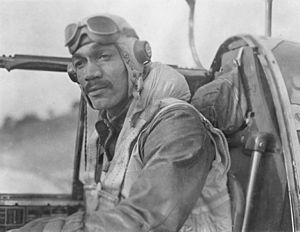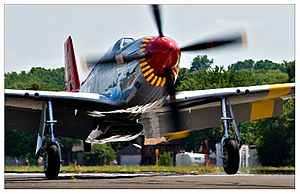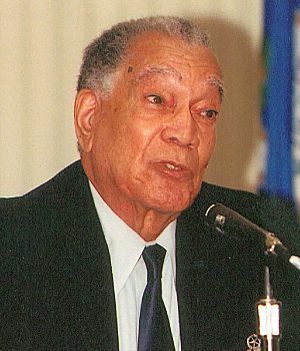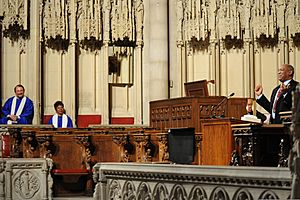Lee Archer (pilot) facts for kids
Quick facts for kids
Lee Andrew Archer, Jr.
|
|
|---|---|

Lee Archer in World War II
|
|
| Nickname(s) | Buddy |
| Born | September 6, 1919 Yonkers, New York |
| Died | January 27, 2010 (aged 90) Manhattan, New York City, New York |
| Buried | |
| Allegiance | United States of America |
| Service/ |
|
| Years of service | 1941–1970 |
| Rank | Lieutenant colonel |
| Unit | 332nd Fighter Squadron Tuskegee Airmen |
| Commands held | 7416th Material Squadron |
| Battles/wars | World War II Korean War |
| Awards | Distinguished Flying Cross Meritorious Service Medal Air Medal (9) Air Force Commendation Medal (2) Congressional Gold Medal |
Lee Andrew Archer, Jr. (born September 6, 1919 – died January 27, 2010) was an African-American fighter pilot during World War II. He was part of the 332nd Fighter Group, famously known as the Tuskegee Airmen.
Archer was one of the first African-American military pilots in the United States Army Air Corps and later the United States Air Force. He eventually reached the rank of lieutenant colonel. During World War II, he flew 169 combat missions. He was credited with shooting down four enemy fighter planes.
Archer was one of only four Tuskegee Airmen who managed to shoot down three enemy planes in a single day. The others were Joseph Elsberry, Clarence Lester, and Harry T. Stewart Jr.
Contents
Early Life and Training
Lee Archer was born in New York and grew up in the Harlem neighborhood of New York City. He later went to New York University. After college, he joined the United States Army because he wanted to become a pilot.
At that time, the Army did not allow black pilots. So, Archer first worked in communications in Georgia. When the Army changed its rules, he was accepted into the pilot training program for black aviators. This program was at Tuskegee Army Airfield in Alabama. He graduated at the top of his class on July 28, 1943, becoming a second lieutenant.
World War II Heroics

Some people consider Lee Archer to be the first and only black U.S. pilot to become an "ace." An "ace" is a pilot who shoots down at least five enemy aircraft. However, during the war, Archer was officially credited with four enemy planes shot down. He also destroyed six aircraft on the ground during a mission in August 1944. He also took out several trains, trucks, and boats.
Archer, nicknamed "Buddy," flew 169 combat missions in Europe. He flew different fighter planes like the Bell P-39 Airacobra, Republic P-47 Thunderbolt, and the North American Aviation P-51 Mustang. His P-51C fighter had the special red tail of the 332d Fighter Group, which was the mark of the "Tuskegee Airmen."
He got his first victory on July 18, 1944, over Memmingen, Germany, when he shot down a Messerschmitt Bf 109.
Archer is best known for his actions on October 12, 1944. During intense air battles over German-occupied Hungary, he shot down three Hungarian Bf 109s. This happened over Lake Balaton, Hungary, in just 10 minutes.
When Archer returned home in 1945, he had received the Distinguished Flying Cross. But he found that society in America had not changed much. He once said, "When I came back to the U.S. and down that gangplank, there was a sign at the bottom: 'Colored Troops to the Right, White Troops to the Left'." This showed the segregation that was still happening.
Archer stayed in the military. The United States Army Air Forces became the United States Air Force in 1947. He flew missions during the Korean War. He also worked as a diplomatic officer and later led the U.S. Air Force Southern Command in Panama. He retired as a lieutenant colonel in 1970.
Life After the Military

After leaving the military, Archer joined General Foods Corporation. He became one of the first black corporate vice presidents at a major U.S. company. He also helped start the food company TLC Beatrice and his own investment firm, Archer Asset Management.
In 2005, Archer and four other Tuskegee veterans visited Balad Air Base in Iraq. They met with servicemen from the 332d Air Expeditionary Wing. This unit was the successor to his old all-black group. Archer said, "This is the new Air Force. I saw black, white, Asian, Pacific Islanders, people from different parts of Europe. This is what America is."
Later Years and Legacy
In April 2009, Archer became an adviser for the George Lucas film, Red Tails. This movie was about the Tuskegee Airmen.
Lee Archer passed away on January 27, 2010, at the age of 90, due to heart problems. His death happened while the Red Tails movie was still being made. The film's final credits included a tribute to him. He is buried at Arlington National Cemetery.
Awards and Honors
Lee Archer received many awards for his service and bravery.
- Distinguished Flying Cross
- Meritorious Service Medal
- Air Medal (9 times)
- Air Force Commendation Medal (2 times)
- Congressional Gold Medal (awarded to him and his fellow Tuskegee Airmen in 2007)
- He received special honors from Presidents Dwight D. Eisenhower, John F. Kennedy, and Lyndon B. Johnson.
- A youth flight training program was started in his honor. It is called the Lee A. Archer Jr., Red Tail Youth Flying Program and helps high school students learn to fly.
See also
- Dogfights (TV series)
- Executive Order 9981
- List of Tuskegee Airmen
- Military history of African Americans
- The Tuskegee Airmen (movie)


